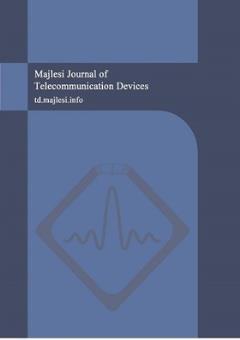Design of Current Starved Voltage Controlled Oscillator with Phase Locked Loop to Estimate the Process Corner Analysis
Subject Areas : Majlesi Journal of Telecommunication DevicesAnnamma k 1 , Sobhit Saxena 2 , Govind Singh Patel 3
1 -
2 -
3 -
Keywords: VCO, PLL, Gain, Gale-or, Lector, Control Voltage, Current starved VCO, Oscillation Frequency, Sleepy Stack, Tuning Range,
Abstract :
This paper consists of a performance comparison of Current Starved Voltage Controlled Oscillator (CSVCO) for Phase Locked Loop (PLL). The design of Current Starved VCO is implemented using sleepy stack low power leakage technique. This has been implemented in 45nm CMOS Technology with a supply voltage of 0.45V in Cadence Software. The parameters such as average power, oscillation frequency, and delay are calculated in different process corners showing the performance of improvement results of cadence simulation. After comparison of the various parameters of PLL implemented with Sleep Stack CSVCO and Basic CSVCO, the sleepy stack approach is particularly useful in low power applications, The recommended PLL has a much smaller chip than previous designs, much lower power consumption and significantly higher efficiency. The proposed design of the PLL with Sleep Stack Technique makes the circuit efficiently to reduce sub-threshold leakage current, and achieves Frequency of 2.759 GHz, Power 2.559µw, phase noise -63.8(dBc/Hz) and Delay(µs) 0.0006544, respectively.
[1] M.Sivasakthi, P. Radhika, “Design and analysis of PVT tolerant hybrid current starved ring VCO with bulk driven keeper technique at 45 NM CMOS technology for the PLL application,” j.aeue.2023.154987, 2023.
[2] C.K. Pothina, N. P. Singh, J. L. Prasanna, C.Santhosh,. M.R Kumar, “Design of Efficient Phase Locked Loop For Low Power Applications”, doi.org/10.3390/2023.
[3] B. Singh, S. Kumar ,R. K. Chauhan, “Design of energy efficient VCO PLL Application Analog Integrated Circuits & Signal Processing”, 2023.
[4] K.B.Meena Kumari, G. Kavya, “Implementation of Digital Phase Locked loop”, Int.. Journal of Egg. Technology and Management Sciences, 2023.
[5] D.M..Ellaithy,Voltage-controlled oscillator-based analog-to-digital converter in 130-nm CMOS for biomedical applications” Journal of Electrical Systems and Information Technology, volume 10, 2023.
[6] kumar P. Chavan, R. Aradhya, “Design of 5.1GHz ultra low power and wide Tuning range Hybrid oscillator,” doi.org/10.11591/ijece. v13i4.pp:3778, 2023.
[7] R Gurjar, DK Mishra, “Design and performance analysis of low phase noise LC-voltage controlled oscillator”,doi.org/10.12928/telkomnika. v21i4.22341,2023.
[8] D. Ellaithy, “Voltage-controlled oscillator-based analog-to-digital converter in 130-nm CMOS for biomedical Applications” DOI:10.1186/s43067-023-00109-x,2023.
[9] P.Thool, J.D. Dhande, Y. A. Sadawarte, “A Review on Design and Analysis of Low Power PLL for Digital Applications and Multiple Clocking Circuits” ISSN: 2321-9653, 2022.
[10] K. Kasilingam, P. Balaiyah, P. Kumar Shukla,”Design of a high-performance advanced phase locked loop with high stability external loop filter”doi.org/10.1049/cds2.12130, 2022.
[11] T .Nirmalraj, , S .Radha krishnan, R. K .Karn, ,”Design of low power, high speed PLL frequency synthesizer using dynamic CMOS VLSI technology”. IEEE, 2022.
[12] T. Bao Phuc Ton,,C. Thinh Dang, “A Design of 45nm Low Jitter Charge Pump Phase-Locked Loop Architecture for VHF and UHF Fields” DOI: 10.21203/rs.3.rs-1804148/v1[4].B , 2022.
[13] S. Dhanush,T.N.Vaishnavi S. Parashar, “Design and Implementation of High Frequency and Low-Power Phase-locked Loop, U.Porto” Journal of Engineering DOI:10.24840/2183-6493_007.004_0006, 2021.
[14] P. Srivastava, R. Chandra Si. Chauhan,”Design of Power Efficient Phase Frequency Detector and Voltage Controlled Oscillator for PLL Applications in 45nmCMOSTechnology”, 2021.
[15] V. Kumar Sharma, “A survey of leakage reduction techniques in CMOS digital circuits for nano scale regime”, Australian Journal of Electrical & Electronics Engineering, DOI: 10.1080/1448837X.2021.1966957, 2021.
[16] B. Dharani, U. Nanda, “Impact of Sleepy Stack MOSFETs in CS-VCO on Phase Noise and Lock Performance of PLL”,DOI:10.1007/s633-021-01446-0, 2021.
[17] Kumar Tiwari,” Leakage Power Reduction in CMOS VLSI Circuits using Advance Leakage Reduction Method”, (IJRASET) , 2021.
[18] R.Prithiviraj, J.Selva kumar , “Design and Analysis of Low power and High Frequency Current Starved Sleep voltage Controlled Oscillator for Phase Locked Loop Applications”, DOI:10.1007/s020-00619-7, 2021.
[19] S. Rani, M. Vinothkumar, K. Krishnamoorthy, “Design of low power VCO using FinFET technology for biomedical applications. Materials Today”: Proceedings, 45, pp.2145–2151. 10.1016/j, 2021.
[20] M. Maiti, S. Kumar Saw, A. J. Mondal, A. Majumder, “A hybrid design approach of PVT tolerant, power efficient ring VCO” doi. org /10. 1016/ j.asej. 2019. 10.009, 2020.
[21] U.Nanda, D.P.Acharya, and D. Nayak,. “Process Variation Tolerant Wide-band Fast PLL with Reduced Phase Noise using Adaptive Duty Cycle Control Strategy”. International Journal of Electronics.2020
[22] Sh.Askari, M.Saneei, “Design and analysis of differential ring voltage controlled oscillator for wide tuning range and low power applications” ,doi.org/10.1002/cta.2582, 2018.
[23] B.S.Choudhury, S.Maity “A low phase noise cmos ring vco for short range device application. In: Conf. proceedings", EESCO-IEEE, 2015.
[24] N. Pathak, R. Mohan, “Phase Locked Loop Design and Implementation using Current Starved Voltage Controlled Oscillator “/IJERTV3IS2074, 2014.
[25] H .Malviya, S. Nayar C. Roy “A New Approach FOR Leakage Power Reduction Techniques in Deep Sub micron Technologies in CMOS Circuit for VLSI Applications” Computer Sci Software Eng. 25, 2013.
[26] PK. Pal, R.S. RathoreAK. , Rana, G. Saini, “New low power techniques: Leakage feedback with stack & sleep stack with the keeper”. In: ICCCT-2010. IEEE. pp.296–301.2010.
[27] J. C. Park and V. J. M. III, “Sleepy stack leakage reduction,” IEEE Trans. Very Large Scale Integrate. (VLSI) Syst., vol. 14, pp. 1250- 1263, 2006.
[28] J. Ch. Park, “Sleepy stack: a new approach to low power VLSI logic and memory”, School of electrical and computer engineering, Georgia institute of technology, 2005.


